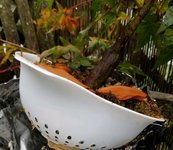Cruiser
Chumono
Has anyone successfully air layered a tree using only pumice?
If it encourages root growth and gets used often for freshly collected material wouldn’t that point to it being effective for layering?
The smaller particles (1-3mm) seem to retain a lot more water compared to larger pieces, and also drains nicely.
Why/why not?
If it encourages root growth and gets used often for freshly collected material wouldn’t that point to it being effective for layering?
The smaller particles (1-3mm) seem to retain a lot more water compared to larger pieces, and also drains nicely.
Why/why not?


